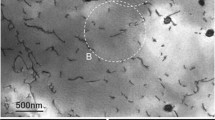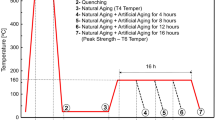Abstract
Center-notched sheet specimens of 5052-H34 aluminum alloy were fatigued at load ratios (R) of 0, 0.2, and 0.43. Crack growth rate at each value ofR was studied as a function of stress intensity amplitude (ΔK) and water vapor or oxygen pressure, referenced to vacuum and laboratory air. Crack rates at a givenR and ΔK were found to increase within the range defined by vacuum and air for a corresponding increase of water vapor pressure but remained essentially constant over the range of oxygen pressures tested. In water vapor a crack rate transition pressure (separating low pressure-low growth rates from high pressure-high growth rates), inversely related toR, was observed. Results are discussed in terms of several models predicting the critical pressure of an active gas environment. A mechanism involving hydrogen embrittlement and one involving a humidity dependent aluminum oxide modulus are both found to be plausible.
Similar content being viewed by others
References
H. J. Gough and D. J. Sopwith:J. Inst. Metals, 1932, vol. 49, p. 93.
H. J. Gough and D. J. Sopwith:J. Inst. Metals, 1935, vol. 56, p. 55.
H. J. Gough and D. J. Sopwith:J. Inst. Metals, 1946, vol. 72, p. 415.
N. J. Wadsworth and 3. Hutchings:Phil. Mag., 1958, vol. 3, p. 1154.
T. Broom and N. Nicholson:J. Inst. Metals, 1960-61, vol. 89, p. 183.
A. Hartman:Int. J. Fract. Mech., 1965, vol. 1, p. 167.
F. J. Bradshaw and C. Wheeler:Appl. Mater. Res., 1966, vol. 5, p. 112.
F. J. Bradshaw and C. Wheeler:Int. J. Fract. Mech., 1969, vol. 5 p. 255.
M. J. Hordon:Acta Met., 1966, vol. 14, p. 1173.
M. A. Wright and M. J. Hordon:Acta Met., 1967, vol. 15, p. 430.
M. J. Hordon and M. A. Wright:Trans. TMS-AIME, 1968, vol. 242, p. 2011.
R. P. Wei:Int. J. Fract. Mech., 1968, vol. 4, p. 159.
R. J. Donahue, H. Mcl. Clark, P. Atanmo, R. Kumble, and A. J. McEvily:Int. J. Fract. Mech., 1972, vol. 8, p. 209.
O. F. Devereux, J. Dresty, and B. Kovacs:Met. Trans., 1971, vol. 2, p. 3225.
M. Hudson and J. T. Scardina:Engr. Fract. Mech, 1969, vol. 1, p. 429.
S. Pearson: RAE TR-6915, 1969.
J. A. Feeney, J.C. Millan, and R.P. Wei:Met. Trans., 1970, vol. 1, p. 1741.
R. P. Wei and J. D. Landis:Int. J. Fract. Mech., 1969, vol. 5, p. 69.
D. A. Meyn:Trans. ASM, 1968, vol. 61, p. 52.
K. U. Snowden:Phil. Mag., 1964, vol. 10, p. 435.
K. U. Snowden:Acta Met., 1964, vol. 12, p. 295.
K. U. Snowden:J. Appl. Phys., 1963, vol. 34, p. 3150.
M. R. Achter and H. W. Fox:Trans. TMS-AIME, 1959, vol. 215, p. 295.
M. R. Achter:Scripta Met., 1968, vol. 2, p. 525.
S. Dushman:Scientific Foundations of Vacuum Technique, J. M. Lafferty, ed., ch. 2, John Wiley, N.Y., 1962.
F. J. Bradshaw:Scripta Met., 1967, vol. 1, p. 41.
R. G. Weber and A. J. McEvily: “The Stress Corrosion Cracking of a Non-Age-Hardenable Aluminum Alloy,” inFracture, 1969: Proceedings of the 2nd International Conference on Fracture, Chapman and Hall, London, 1969.
W. H. Bray:J. Mater., 1970, vol. 5, p. 233.
A. J. McEvily and R. P. Wei: “Fracture Mechanics and Corrosion Fatigue,” inCorrosion Fatigue: Chemistry, Mechanics, and Microstructure, NACE, Houston, 1972.
M. Speidel: “Hydrogen Embrittlement of Aluminum Alloys?”, presented at Conference on Hydrogen Embrittlement, Seven Springs, U.S.A., Sept. 1973, to be published.
D. Broek: Discussion in Ref. 12.
J. Grosskreutz:Surface Sci., 1967, vol. 8, p. 173.
J. Grosskreutz: “The Effect of Surface Films on Fatigue Crack Initiation”,Corrosion Fatigue: Chemistry, Mechanics, and Microstructure, NACE, Houston, 1972.
R. Weeks, J. Dundurs, and M. Stippes:Int. J. Engr. Sci., 1968, vol. 6, p. 365.
G. H. Connors:Int. J. Engr. Sci., 1967, vol. 5, p. 25.
J. Grosskreutz:J. Electrochem. Soc, 1969, vol. 116, p. 1232.
N. Cabrera and F. Mott:Rept. Progr. Phys., 194849, vol. 12, p. 163.
J. Grosskreutz and M. B. McNeil:J. Appl. Phys., 1969, vol. 40, p. 355.
Author information
Authors and Affiliations
Rights and permissions
About this article
Cite this article
Enochs, J.S., Devereux, O.F. Fatigue crack growth in 5052-H34 aluminum in vacuum and active gas environments. Metall Trans A 6, 391 (1975). https://doi.org/10.1007/BF02667295
Received:
DOI: https://doi.org/10.1007/BF02667295




